In the distance, roosters crow at dawn as the thrusters of the ship rumble to life, docking at Key West, home of Hemingway, six toed cats and wild chickens that roam the streets and cafes.
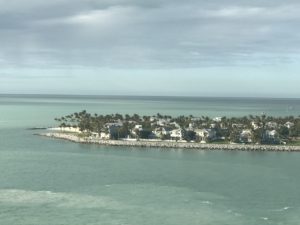
KeyWest
Key West has the reputation of being a laid back island, just 90 miles from Cuba. It’s the furthest west of all the Florida Keys and just 4.2 square miles. But perhaps its greatest claim to fame is as the home of Ernest Hemingway from 1931 to 1939 where he lived with his second wife Pauline. It was here, at 907 Whitehead Street, across from the Key West Lighthouse that he wrote some of his best known short stories and novels including To Have and Have Not and Green Hills of Africa, a work of non-fiction.
His home was built in 1851 in the Spanish Colonial style. It has been fully restored and is now open to tours (bring cash, they don’t accept credit cards). The house and grounds are beautiful. In a small bungalow next to the house, Hemingway wrote. For years a cat walk connected the small office with the main house…

Hemingway’s typewriter and office in Key West
and of course, the six toed cats!
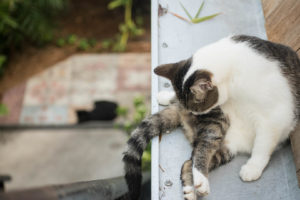
Cats above and cats below at Hemingway’s house in Key West
The six toes cats present on the property today are the result of a gift and a careful breeding program run by the museum management. The original cat, Snow White was a gift from a sea captain named Stanley Dexter in the 1930’s. Sailors believed that polydactyl cats were good luck, and perhaps they are. Irma’s recent Caribbean rampage left Hemingway’s house relatively unscathed.

Howard Hughes, one of the polydactyl (six-toed) cats at the Hemingway House in Key West
Forty to fifty six toed cats wander the grounds at will. All are named after movie stars of Hemingway’s period. So one might find Cary grant chasing Fred Astaire or Ginger Rogers hanging with Lauren Bacall. They are well socialized (except for Howard Hughes who is a bit of a recluse, hanging out alone in the basement).
One of the best stories to come out of the house is the story of the massive swimming pool which in 1938 cost $20,000. It was the only pool within 1,000 miles. Poet Elizabeth Bishop, a friend of Hemingway’s wife Pauline, wrote of the famous pool in one of her letters to Robert Lowell:
“ . . .The swimming pool is wonderful -it is very large and the water, from away under the reef, is fairly salt. Also it lights up at night -I find that each underwater bulb is five times the voltage of the one bulb in the light house across the street, so the pool must be visible to Mars -it is wonderful to swim around in a sort of green fire, one’s friends look like luminous frogs . . .”
The swimming pool was also very high maintenance. The salt water would have to be drained every few days, the pool scrubbed down and then the refilling process would start again. According to the Hemingway Home website, and contrary to many stories, the pool was actually the mastermind of Ernest, not his wife Pauline who would be stuck overseeing the project while Hemingway’s travels as a war correspondent took him overseas during the Spanish Civil War. Hemingway is said to have commented “Pauline, you’ve spent all but my last penny, so you might as well have that!” He flipped a penny into the air, and it landed on the concrete where it would be permanently embedded in the patio.

Penny embedded in concrete poolside at Hemingway’s House in Key West
Hemingway is at once a galvanizing and polarizing figure. His larger than life persona of traveler, adventurer, gambler, drinker, womanizer– a “manly man”– the perfect “synthesis of brain and brawn”.
“To me heaven would be a big bull ring with me holding two Barrera seats and a trout stream outside that no one else was allowed to fish in and two lovely houses in the town; one where I would have my wife and children and be monogamous and love them truly and well and the other where I would have my nine beautiful mistresses on nine different floors.” –Ernest Hemingway, letter to F. Scott Fitzgerald, July 1, 1925
There is no doubt Ernest lived with gusto. Yet this 1954 Nobel Prize winner killed himself July 2, 1961 at age 61. He had bipolar disorder and possibly several other psychiatric problems as well. Dr. Christopher Martin, MD, a board certified psychiatrist in Houston, Texas, affiliated with Michael E. DeBakey Veterans Affairs Medical Center and an Assistant Professor at Baylor College of Medicine has written a cornerstone paper on Hemingway and his psychological issues.
In this paper, Dr. Martin points out that some of the Hemingway myth begins to unravel. His war record, for instance. Hemingway was only 18 when he volunteered in World War I. His defective left eye meant that he entered the war not in combat, but as a non-combatant. In Paris, he evidenced mood swings and a tendency to turn against those who helped him. In Africa a string of accidents left a string of questions behind.
Dr. Martin dives deep into Hemingways upbringing and adult bravado to look at the real man behind the legend. The best summary of this study is in the article “Being Ernest.” It’s a fascinating read, about the fascinating, if highly human, man behind the myth.
Regardless of where the truth might lie, Hemingway cut a swashbuckling figure in literature and life. Hemingway was remembered in a 1966 memorial in Sun Valley. The eulogy had actually been written by Hemingway for a friend, but it certainly applied to him as well:
Best of all he loved the fall
the leaves yellow on cottonwoods
leaves floating on trout streams
and above the hills<
he high blue windless skies
…Now he will be a part of them forever.
And today, the legacy of his six toed cats lives on.
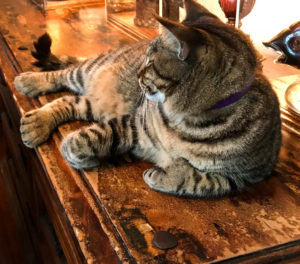
Six toed cat, a descendent of Snow White, at Hemingway’s house in Key West
Click here to view the Gallery pictures from Key West!
Roosters and Garlic
Roosters–or perhaps I should say chickens– roam Key West at will. That’s because the Cubalya chicken, a beautiful stately bird, was imported into Key West then later abandoned. They were originally imported for cockfighting, a popular Cuban pastime. But when the fighting was outlawed in the 1970’s the birds were left to fend for themselves.

Red topped Cubalaya rooster Key West
But onto garlic. Not necessarily with chicken (although that always has promise) but with shrimp for a spicy, light lunch.
Food is always a part of my travels. I’m inclined towards small bites with lots of flavor. Gone are the days of a plateful of food! Less is more, as long as taste isn’t comprised.
I stopped in a Caribbean restaurant–the name now eludes me–where I enjoyed a plate of garlic with shrimp. More or less in that order. A few roasted peppers, topped with a sprinkling of parsley. And it was wonderful. Just right.
I sat and looked out over the sculpture park across the way. Chickens wandered here and there. One wandered right into the restaurant. No one seemed to mind. They are simply part of the landscape.
Key West has a strong tourist vibe, but when you get off the main shopping streets the roadways and architecture are captivating. The island’s Old Town historic district is comprised of almost 3,000 buildings and is believed to be the largest predominantly wooden historic district in the U.S.
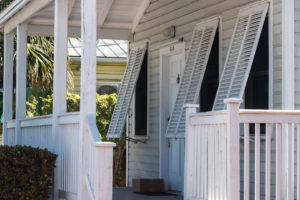
Shuttered house in Key West
Part of the architectural history of Key West is the conch house. Conch houses are built of wood, set up on posts. This allows air to circulate, and water to pass under. Weatherboarding, low gabled or hip roofs and double-hung sash windows are common features. Later victorian ornamentation would also be integrated into the island’s architecture resulting in a charming island mix of color and style. There are numerous house pictures in the gallery on Key West.
Click here to view the Gallery pictures from Key West!
In “To Have and Have Not”, perhaps in one of Hemingway’s more mercurial moods, he predicted the death of all that brought charm to the island:
“What they’re trying to do is starve you Conchs out of here so they can burn down the shacks and put up apartments and make this a tourist town. That’s what I hear. I hear they’re buying up lots, and then after the poor people are starved out and gone somewhere else to starve some more they’re going to come in and make it into a beauty spot for tourists.” —To Have and Have Not
Thankfully he was wrong and Key West remains a gem of an island, particularly as you wander away from the tourist shops and into the neighborhoods and streets that lay beyond.
More On Florida:
Key West
Weekend in Ft. Lauderdale
11 Things To Do In St. Augustine
Little Havana, Miami
The Sanderlings of Florida
St. Augustine
Traveling the Timeline of Now
A Cuban Inspired Culinary Tour in Miami’s Little Havana
Like this Post? Pin it!
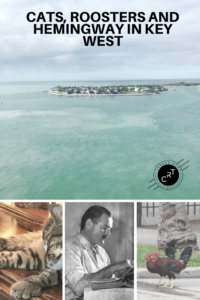
Cats, Roosters and Hemingway in Key West
If you’re interested in learning more about photography (or cooking or film or any number of topics) check out Masterclass for on-line excellence:
What is #CancerRoadTrip and how did it come to be? Read this post to get the backstory!
Follow me on Twitter, Pinterest, Instagram, and at Anti-Cancer Club. Connect with me! I may need a place or two to stay along the way!
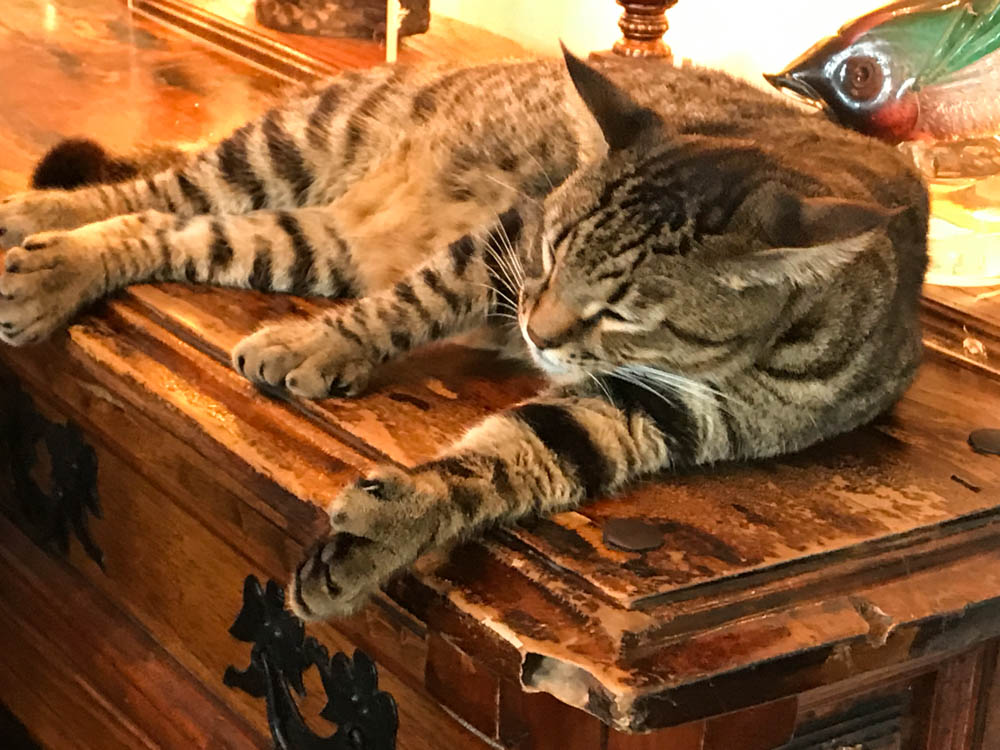










Thanks for your personal marvelous posting! I quite enjoyed reading
it, you may be a great author.I will be sure to bookmark your blog and
will eventually come back later on. I want to encourage you continue your great writing,
have a nice morning!
Thank you! I post about once a week with a number of photo galleries ready to come out as well. I greatly appreciate your encouragement! All my thanks!